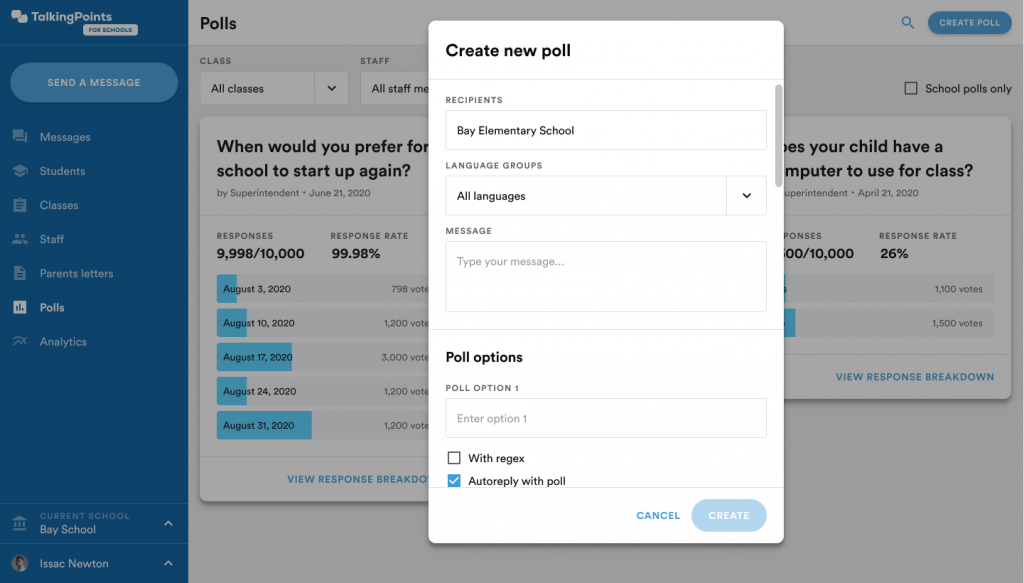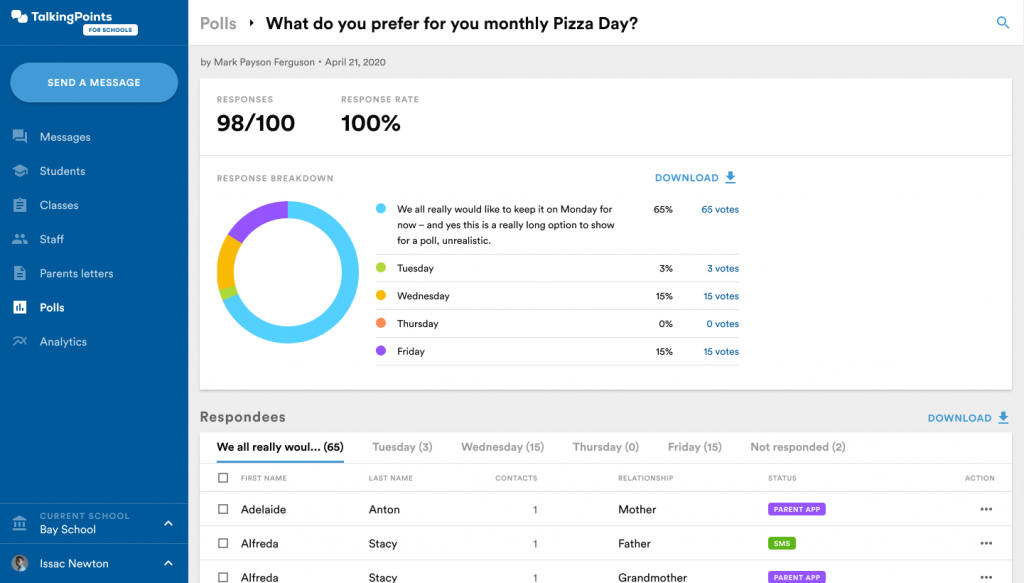Written by Paige DeLozier
Whether you’ve just gained the ability to send polls to families or you’re wanting to take advantage of your account’s built-in features, we want to share some best practices so you can get the most out of our polls feature.
Read on to learn our tips and tricks for sending TalkingPoints polls.
Polling in action
Polling is a quick, easy way to get information about a topic from all the families you serve. Ask a simple multiple-choice question, and get immediate aggregated results you can use to inform classroom or school planning processes.
Principal David Legrand of Independence High School in North Carolina ran an experiment to see just how helpful the TalkingPoints polling feature would be in gathering family responses to a food giveaway event. So, he compared responses from the previous year, which were gathered via phone call, to the current year, gathered using TalkingPoints. He was very impressed with the increase in responses he got using TalkingPoints polls and how much more efficient the process was. See for yourself!

Polling best practices
Polls are a great tool to quickly gather information from your community about a question you’re trying to answer. To get the best response rates from families, remember to keep in mind best practices for writing for translation, which will help ensure the message translates correctly for your non-English families.
Here are some other best practices to consider:
- Focus on the audience. Parents are experts on their children, but not trained educators. Remember to compose the message in a way that respects their role as a family member and/or guardian but does not expect them to know every educational term or phrase you do.
- Ask one question at a time. Each poll should only be focused on one question. This removes the possibility of confusion when the parent is trying to answer the question. You can always send follow-up questions in a second poll or a direct message if you need additional information.
- Keep answer choices short and to the point. Many parents will see the poll on their phone, so it’s important to keep answer choices short. Polls become difficult to process and can cause confusion (especially when they’re being translated) if the answer choices are longer than a few words. Try to make each answer choice a bite-sized summary rather than a long explanation.
- Include all answer options. Not all polls will be Yes or No questions. Make sure before sending, you think through all the answers a family may want to provide to the poll. Include an answer of “Other” when you think there may be one you’re not anticipating.
- Prepare for follow-up questions. Some questions require more information. This could be as simple as sending a direct message to one family to have a conversation, but if it’s more than that, try to think ahead about the possibility of needing to send a follow-up poll. In admin accounts, you can even do this as you compose the initial poll!

Poll results and analytics
Viewing the results of your poll will look different depending on what kind of TalkingPoints account you have. In a TalkingPoints for Teachers account, you can simply click on the poll itself in the main dashboard to view the percentage of responders in each category and who they were.
For administrators, there is a more in-depth analysis of poll results. To view this, follow the steps below.
- Select the “Polls” tab in the left-hand sidebar of the dashboard.
- Find the poll you’d like to view and click “View Response Breakdown”.
- Here, you can view responders for each answer choice, download and print reports, and send follow-up polls to responders by answer choice.

Want to learn more?
TalkingPoints’ easy-to-use platform, interactive features, and precise translation in over 100 languages can provide game-changing solutions for bridging the home-school gap for teachers, school districts, and families. Learn more about our services here, and contact us at hello@talkingpts.org to learn more about how TalkingPoints can increase family engagement, improve home-school connections, enhance relationships between teachers and families, and support academic and social-emotional growth for every student.
For updates and news on what we’re up to, follow us on Facebook, Instagram, and Twitter. Check out our blog for free resources on remote learning and family engagement and see how other teachers are using TalkingPoints to make a difference in their students’ learning.



